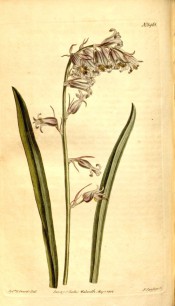Hyacinthoides non-scripta (L.) Chouard
Fully-hardy vigorous, clump-forming, bulbous perennial with spreading, lance-shaped leaves and one-sided racemes, bent over at the top, of 6-12 pendant, narrowly bell-shaped, scented, mid-blue, occasionally pink or white, flowers. To 40cm. [RHSE, Hortus].
Horticultural & Botanical History
‘This plant, the Hyacinthus cernuus of the above-cited work of Linnaeus [Species Plantarum ed. 2. 1. 453], is, as we have stated in the latter part of the article Scilla campanulata in No. 1102, a variety of Scilla non scripta, and not to be confounded with the pink one of the species we are there speaking of. In the same place will be found our opinion of that which misled Linnaeus to consider the plant as distinct from his H. non scriptus, and to adopt, as distinctions between them, marks that are nowise constant as such; as well as to speak of it as peculiar to Spain. When he describes the degree of bending in its raceme, which he does in a note, it is plain he could not have had a variety of campanulata in view; although the specimen in the Banksian Herbarium shews that the compilers of the first edition of the Hortus Kewensis afterwards had; in the last edition indeed there is no mention of the species as distinct from non scripta and campanulata. Miller had observed that the plant appeared to be a mere variety of the English Harebell. We insert Gerard’s account of the species: “The blew harebells or English Jacinth is very common throughout England. The white English Jacinth is altogether like the precedent, saving that the leaves of this are somewhat broader, the flowers more open, and very white of colour. There is found wilde in many places of England another sort, having flowers of a faire carnation colour, which maketh a difference from the other. The blew Harebells grow wilde in woods, copses, and in borders of fields every where thorow England. The other two are not so common, yet do they grow in the woods by Colchester in Essex, in the fields and woods by South-Fleet neere unto Gravesend in Kent, as also in a piece of ground by Canterbury, called the Clapper; in the fields by Bathe, about the woods by Warrington in Lancashire and other places.” Parkinson mentions the species as varying with flowers “of a fine delayed purplish red or blush-colour.” We have given neither specific character nor description in our article, those of the blue variety having been so frequently and so fully given in other works; and the differences between it and campanulata will be found stated in No. 1102. The drawing was made from a specimen that was sent us last spring from Mr. Haworth’s garden, at Little-Chelsea.’ [BM t.1461/1812]. The pink form is figured. Hortus lists delicata, pale pink; rosea, rose or pink; and rubra, reddish.
History at Camden Park
Listed in all published catalogues [B.407/1843].
Notes
Published Jan 09, 2010 - 04:46 PM | Last updated Jan 09, 2010 - 05:08 PM
| Family | Hyacinthaceae |
|---|---|
| Category | |
| Region of origin | Western Europe including Britain |
| Synonyms |
|
| Common Name | English bluebell |
| Name in the Camden Park Record | Scilla non-scripta |
| Confidence level | high |
